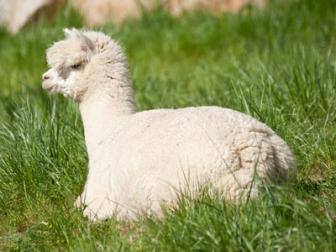
By TreeLiving.com
Virtually unknown in the United States just a few decades ago, the alpaca has already become a very popular domesticated animal, particularly for hobby farmers. Originally native to the Andes Mountain region in South America, alpacas are closely related to camels and llamas.
Unlike most other domesticated livestock, though, the alpaca is not bred or kept for its abili ty to work or for its meat or milk, but for its coat. Alpaca fiber (referred to as “wool”) is preferred by many individuals over traditional wall that comes from sheep. The alpaca wool is warmer and softer than sheep’s wool, and does not trigger any allergic reactions. It’s hypoallergenic because it does not have lanolin as sheep’s wool does, but this makes that alpaca wool not as water-friendly as sheep’s wool.
Alpacas are one of the most eco-friendly types of livestock farmers can raise. Because their wool is so soft and naturally occurs in a number of different colors, there is very little treatment required before alpaca wool can be woven into clothing. A single alpaca can generate a surprising amount of fiber each season, making them a valuable renewable resource for clothing. In contrast, the processes for creating synthetic fiber clothing, or even cotton that is produced on industrial farms, is much more resource intensive, and generates undesirable chemical waste products.
The alpacas themselves are biological marvels. Each alpaca consumes far less water and food than other types of domestic livestock. Even the alpaca’s grazing techniques are more environmentally friendly than other animals. Rather than rip the grass from the ground, they merely eat the top portion, leaving the root system intact so that the grass can continue to grow (as well as prevent erosion).
Alpaca waste is a better natural fertilizer than that of other livestock, and there’s an interesting trait of alpacas that makes it easier to use their dung as a fertilizer on other parts of the farm. Alpacas tend to use a designated area of their grazing field as a community “bathroom.” Unlike cows and horses – who simply go whenever and wherever they are (which can expose them to the possibility of infecting themselves and other livestock with waste born illnesses) – alpacas do not go to the bathroom near the areas where they eat.
Individuals who already have experience with keeping livestock should find very little difficulty in farming alpacas. Depending on the quality of the pasture, it’s possible to raise up to nine or ten alpacas per acre. The alpacas are a very hearty species, so only very basic housing will be needed during colder months. Of course, like other livestock of its size, and alpaca farmer may need to make sure there is adequate fencing in order to protect against coyotes and other predators.
The prices for alpacas vary widely, although a new farmer may expect to pay between several thousand to $10,000 per animal. The prices have fallen a bit in the past few years, as the initial popularity (and notoriety) of raising alpacas has come and gone. What remains today is a less speculative venture that could be a great fit for the right kind of environmentally conscious farmer.

